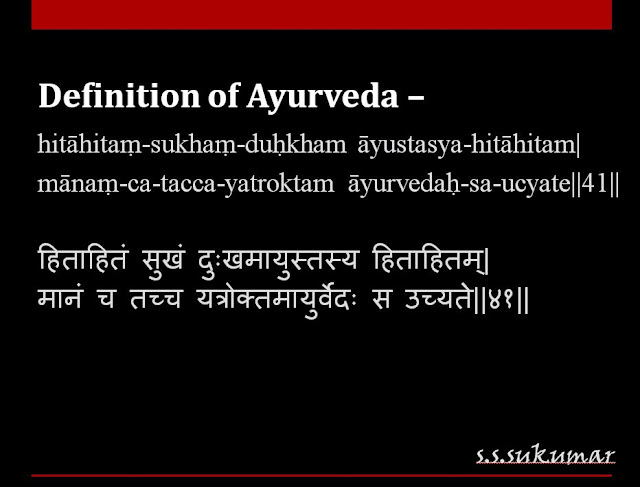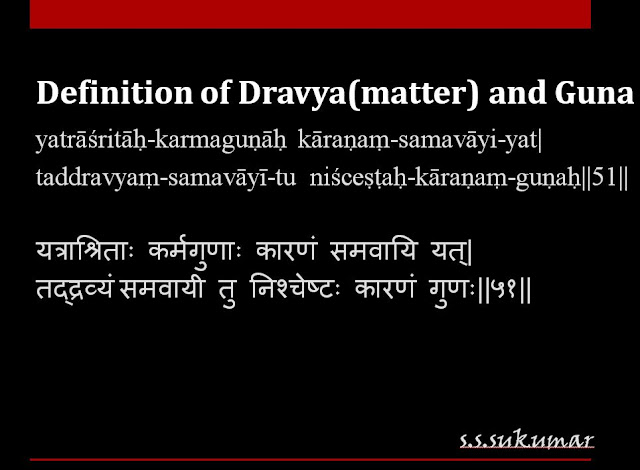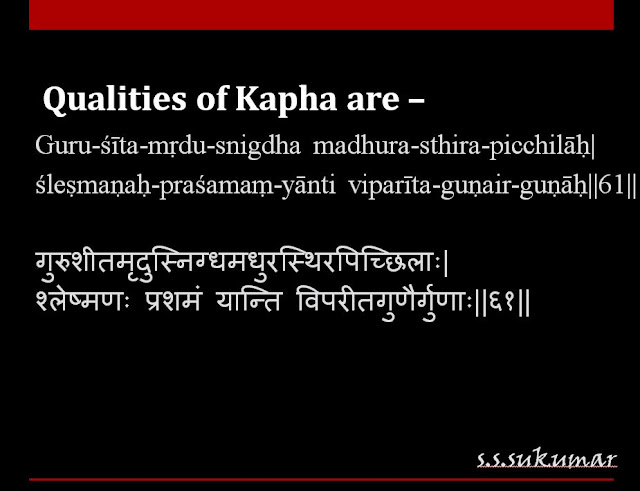Lord Brahma recollected the knowledge of Ayurveda and passed it on to Daksha Prajapati. From him, the sacred knowledge of Ayurveda was passed on to Ashwini Kumaras (Ashwini twins who are considered as doctors for Devatas (divine souls). From them, Lord Indra learnt Ayurveda.
Saint Bharadwaja, being desirous of long life, having known about Indra,
approached Indra and learnt about Ayurveda.
Purusharta or 4 objectives of life:
Good health stands at the very root of
1.Dharma – righteousness, virtuous acts,
2.Artha – acquirement of wealth and prosperity,
3.Kama – fulfilling desires
4.Moksha – Renunciation.
These are the 4 objectives of life
Trisutra or principles of ayurveda viz.,
1.Hetu – causative factors of disease
2.Linga – symptomatology
3.Aushadha Jnana – knowledge of therapeutics, treatments and medicines.
Hetu, Linga and Aushadha are known as Trisutra – the three formulas of treating disease.
Shat padartha's are :
1.Samanya (common),
2.Vishesha (specialty),
3.Guna (qualities),
4.Dravya (substance),
5.Karma (action) and
6.Samavaya (inseparable).
These are the various categories as enumerated in the Nyaya system of
philosophy.
Six disciples of atreya punarvasu are:
1.Agnivesha
2.Bhela
3.Jatukarna,
4.Parashara
5.Harita
6.Ksharapani.
Definition of Ayurveda –
Ayurveda is the science of life which explains about remedy for:
1.Hitayu – advantageous life
2.Ahita Ayu – disadvantageous life
3.Sukhayu – happy state of health and mind
4.dukhayu – unhappy state of health and mind. It also explains what is good
and bad for life and measurement of life
Definition of Ayu (life) –
The term ‘Ayus’ stands for the combination of the :
*Shareera – body,
*Indriya – sense organs,
*Satva – mind and
*Atma – soul.
This means that when the body is intact with sense organs, mind and soul,
then one has life. Otherwise not.
Synonyms of life are:
-Dhari – the one that prevents the body from decay,
-Jeevita – which keeps alive,
-Nityaga which keeps the soul, mind and sense in tact with the body all the
time, without discontinuation.
and
-Anubandha which transmigrates from one body to another (after death).
Superiority of ayurveda:
As it is beneficial to mankind in respect of both the worlds i.e. this life and the life beyond, Ayurveda, the most sacred and honored by those proficient in the Vedas will now be expounded.
Theory of common and Difference –
1.Samanya- Common features and characteristics lead to growth. For example, Kapha dosha has oiliness. and if we take oily food, Kapha dosha increases in the
body.
2.Vishesha- Difference or specialties in characteristics lead to division and
degeneration or depletion. [44 - 45]
For example, Dryness is opposite to Kapha Dosha. If we eat foods having
dryness, it decreases the Kapha Dosha
Tridanda:
1.Satva (Mind)
2Atma (soul)
3.Shareera (body) – these three
are Tripods of life.
The world is sustained by their combination; They constitute the basis for everything.
Nava karana dravya –
1.Prithvi – earth
2.Ap – water,
3.Tejas – fire,
4.Vayu – air and
5.Akasha – ether
Together with
6.Atma (soul)
7.Mana (mind)
8.Kala (time)
9.Disha (space) -
these nine are basic matter.
Ayurvedokta 41 gunas They are –
20 Guru adi gunas +
10 Paradi Gunas+
6 Atma guna +
5 Sartha Gunas are the total qualities.
5 sartha or Objects of sense organs –
1.Shabda (sound- perceived byears) ,
2.Sparsha (touch perceived by skin)
3.Roopa (shape perceived by eyes),
4.Rasa (taste) and
5.Gandha (smell),
20 Guru adi gunas -
Guru (heavy) X laghu (light in weight)
Manda (slow) X tiksna(quick,fast)
Hima (cold) X ushna (hot)
Snighda (unctuous) X ruksa (dry)
Slaksna (smooth) X khara (rough)
Sandra (solid) X drava (liquid)
Mrdu (soft) X kathina (hard)
Sthira (stable) X cala (moving, unstable)
Suksma (stable, small) X sthula (big,gross)
Vishada (non slimy) X picchila (slimy)
knowledge which includes
6 Qualities of Atma (soul) –
1.Iccha – desire
2.Dvesha – hatred
3Sukha – comfort, happiness
4.Dukha – grief
5.Buddhi – intellect
6.Prayatna – effort
Paradai gunas
1.Para – great,
2.Apara – not great,
3.Yukti – planning,
4.Samkhya – number
5.Samyoga – combination,
6.Vibhaga – division,
7.Pruthaktva – individuality,
8.Parimana – quantity,
9.Samskara – processing,
10.Abhyasa – habituation
All these together constitute qualities.
Samavaya:
is the inseparable relationship. Such a relationship exists between Prithvi and Gandha (earth and smell), Ap and rasa (water and taste) Tejas and Rupa (Fire and shape) Vayu and Sparsha – air and touch)
Akasha an Shabda (ether and sound)This is eternal because where there is matter, its distinctive quality is always there.
Dravya:
The one having qualities (Guna) and action (Karma) in an inseparable
relation is called as matter (Dravya). [51] For example, ghee (matter) has
oiliness (quality) and decreases Vata (action).
Definition of qualities (Guna):
That which has inseparable relationship with matter but does not have its
own action, is called as Guna. [51]
For example, the oiliness (quality) in ghee (matter) lives inseparably. But
oiliness itself does not have any action. The Vata decrease action is done
by the ghee (matter).
Karma:
That which lives inseparably with matter (Dravya), which causes combination and separation. Karma makes the matter to act without depending on anything else.
Karya – aim of work (in Ayurveda):
The aim of the work in Ayurveda is to bring balance to all the factors in the
body (Dhatu Samya). Restoring this balance is the purpose of Ayurveda.
Threefold Cause for disease –
The cause of the diseases relating to both (mind and body) are:
1.Atiyoga – excessive utilization or indulgence
2.Heena Yoga- less utilization or indulgence
3.Mithya Yoga – wrong utilization of
Kala – time (like prolonged summer, short summer or heat of summer in other seasons)
Artha – objects of sense organs (smell, touch etc) (like excessive smelling, not at all seeing, or seeing in dark areas, seeing of sharp objects etc and
Buddhi – mental faculties – like excess thinking, less thinking or wrong
thinking and doing etc
Two places where disease occur:
1.The body and
2.mind constitute the substrata of diseases and happiness. Balanced utilization of time, mental faculties and object of sense organs is the cause of happiness.
Definition of atma:
Nirvikara – The soul is essentially devoid of all deformities.
He is the cause of consciousness through the mind and the specific
qualities of basic elements (touch, shape, smell, taste and sound). He is
eternal. He is an observer – he observes all activities.
Physical and mental dhoshas:
Pathogenic factors in the body are
1.Vayu (Vata)
2.Pitta
3.Kapha
Mental Doshas are
1.Rajas
2.Tamas.
Three types of treatments for these two types of Doshas –
The physical Doshas – Vata, Pitta and Kapha are balanced by
a. Daiva Vyapashraya Chikitsa – religious rites and
b. Yukti Vyapashraya Chikitsa – done by a physician with proper planning.
The psychological Doshas – Rajas and Tamas are balanced by spiritual and scriptural knowledge, patience, memory and meditation. These treatments helps to win over the weakness of mind. Hence it is called Satvaavajaya Chikitsa
Qualities of Vata Dosha -
1.Rooksha (rough),
2.Sheeta (cool),
3.Laghu (light),
4.Sookshma (subtle, minute),
5.Chala – mobile,
6.Vishada – clarity, non-slimyand
7.Khara (coarse) are the qualities of Vata. It is balanced by the medicines with opposite to these qualities.
Qualities of Pitta Dosha –
1.Sneha (unctuous),
2.Ushna (hot),
3.Teekshna(sharp, piercing),
4.Drava (liquid),
5.Amla (sour),
6.Sara (fluidity)
7.Katu (pungent) are Pitta’s qualities. It is balanced by the medicines with opposite to these qualities.
Qualities of Kapha are –
1.Guru (heavy),
2.Sheeta (cool),
3.Mrudu (soft),
4.Snigdhna (unctuous, oily)
5.Madhura (sweet),
6.Sthira (immobile)
7.Picchila (slimy)

Principle of Tridosha Balance –
The curable diseases are cured by
medicines possessing opposite qualities, when administered with due regard to the place, dose and time. No medicine is to be prescribed for incurable diseases.
Taste –
Ap (water) and Prithvi (earth) constitute the substratum for the
manifestation of taste (Rasa). Taste is the the object of Tongue
(Rasanendriya). Akahsa (ether), Vayu (air) and Tejas are responsible for
the manifestation of different types of taste.
1.Sweet (Madhura),
2.Sour (Amla),
3.Salt (Lavana),
4.Katu (pungent),
5.Tikta (bitter and
6.Kashaya (astringent) are the six types of Tastes.
Rasa effect on tridosha:
On vata:Medicines and food having sweet, sour and saline taste balance Vata;
On pitta:Those having astringent, sweet and bitter (taste) balance Pitta and
On kapha:those having astringent, pungent and bitter tastes balance Kapha.
Three types of medicines –
1.Doshaprashamana - Which balance the increased Dosha.
2 Dhatu pradushana - Which imbalance the normal Doshas to abnormal
stage
3.Swasthavrutta - which maintain the health in its normal state.
Four varieties of fat :
1.ghee(grutha)
2.oil(taila)
3.muscle-fat (vasa)
4.marrow. (majja)
They are prescribed for internal use, massage, enema and inhalation. All these varieties of fat add to the unctuousness, invigoration, luster, strength, corpulence (of the body) and alleviate Vata, Pitta and Kapha.
Five varieties of salt are :
1.Sauvarchala (sochal salt),
2.Saindhava (rock salt),
3.Vit (Amonium chloride),
4.Audbhida (salt from the earth), and 5.Samudra (sea salt).
They are all unctuous, hot, sharp and most exceedingly appetizing.
Utility of salta:
They are also used for anointment, causing unctuousness, fomentation, purgation, emesis, Niruha, Anuvasana (types of enema – basti treatment), massage, intake, elimination (of Doshas) from the head, surgical measures, suppositories, collyrium, unction, and also for the correction of indigestion, constipation, treatment of diseases due to Vata, Gulma (abdominal
tumour), Shoola (colic pain) and Udara (abdominal diseases including ascitis). This is about salts.
One who knows the principles of their correct application in consonance
with the place, time and individual variation, should be regarded as the
best physician.
Wisdom of right usage of medicine –
A drug not known is likened to poison, weapon, fire and thunderbolt while the one known, to the nectar. A drug known in respect of its name, form and properties or even if known, improperly administered, leads to bad consequences.
Even an acute poison can become an excellent drug if it is properly administered. On the other hand even a drug, if not properly administered, becomes an acute poison.
Successful treatment:
Accomplishment of all objects i.e. actual prevention and cure of diseases
implies the proper application of medicine. Success also implies the
presence of best physician endowed with all good qualities.


































Nice....👍
ReplyDelete